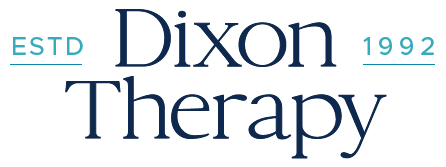
The Dixon Method
An Integration of Occupational & Myofascial Release Therapies
The Dixon Method is an approach that understands and treats patients as a whole person rather than their presenting diagnosis.
Lori Dixon, OT/L
The Dixon Method Approach
Understand your pain or problem that has caused you to seek treatment.
Understand the extent of the physical problems you are experiencing, not just your diagnosis. (Many times all of these problems may be related.)
Understand your complete medical history. Including surgeries, and accidents.
Understand how this impairs your lifestyle, along with your ability to care for your personal needs, family and home.
Our goal is to get you better so that you can return to your normal work and your leisure activities.
Integrating Occupational & Myofascial Release Therapies
Understanding Occupational Therapy
Occupational therapy is a health and rehabilitation profession focused on helping people regain, develop and build skills that are important for independent functioning, health, well-being, security and happiness.
As licensed occupational therapists, we work with people of all ages who, because of illness, injury or developmental or psychological impairment, require specialized assistance to [re]learn skills that enable them to lead independent and productive lives.
Occupational therapy is designed to help patients manage pain, regain performance skills lost through injury, maximize independence, promote and maintain health, and prevent injury or disability.
Understanding Fascia
You’re familiar with the skeletal system as well as the muscular system. Meet the fascia system, which connects the skeletal system to the muscular system. This is why we also refer to fascia as connective tissue.
Fascia can be thought of as the connective tissue that holds the human body together. The fascia is the 3-D spider web of fibrous, gluey proteins that bind cells together in their proper placement.
Fascia has been relatively ignored, possibly because it doesn’t show up on MRIs, CT scans or x-rays so it’s been easy to overlook. It also explains why imaging may not present the whole picture of your symptoms.
At Dixon Therapy, we see Occupational Therapy as the foundation to rebuilding healthy outcomes for our patients in pain. By combining Myofascial Release Therapy with Occupational Therapy, we are creating success for our patients in pain.

You can trust your care to Dixon Therapy
By doing so, you’ll receive the highest quality personal, one-on-one therapy by a medical professional in a comforting environment where time can be spent as needed listening to your needs, adopting a personalized treatment plan, and taking care of your pain.
To get started, please call our office, and I will see to it that you are provided our very best attention and care.
Case Study: Karen
Karen was referred to me for treatment for chronic neck pain. She had suffered with chronic neck pain for over 15 years.
She had tried traditional physical therapy with no success. She was married and an at home mother raising 3 small children so she just learned to live with the pain.
Treatment included myofascial release. After each treatment session, she was pain free. Unfortunately her chronic neck pain would return after a few days.
One day out of frustration, I asked if I could just take a few minutes and look at her. I notice her posture was poor and she had markings around her bellybutton. I asked if these markings were scars or stretch marks. She explained that these marks were scars because she had had numerous gynecological procedures going in through her bellybutton.
I decided to treat the scar tissue in her bellybutton. Immediately she felt pain going from her bellybutton up into her neck. After treating the scar tissue in her bellybutton for 2 sessions, she was pain free and had made a complete recovery from her chronic neck pain.
The scar tissue in her abdomen had become tight and contracted over the years and was pulling on her posture causing her chronic neck pain.
With myofascial release, I was able to soften and release this scar tissue and take the pressure off of her neck. This is an example of treating someone as a person not just her diagnosis and digging into her history and figuring out where the cause of her pain was coming from.
Case Study: Dana
Dana was referred to me as a 42 year old woman with a frozen shoulder. She was a breast cancer survivor and had gone through a mastectomy and reconstruction. She was relieved and grateful that she was cancer free but also felt devastated by the pain and disfiguring surgeries.
After interviewing her, she complained of the pain and tightness that limited her left shoulder movement. She also complained of the disfiguring scarring to her chest that was tight, restrictive, painful and made it difficult to breath. She hated to complain because she was grateful to be alive but she was devastated by how debilitating and painful the scar tissue was.
Our goals in occupational therapy were to relieve her of her pain to her chest and left shoulder, Improve her movement and flexibility to her left shoulder and improve her ability to breathe deeply, and improve her ability to use her arm to return to her normal activities.
With myofascial release, we were able to soften her scar tissue and relieve her pain, improve her movement and flexibility to her left shoulder, and improve her ability to breathe deeply and relax again. These improvements helped her recover physically and emotionally from her cancer.
Case Study: Rhonda
Rhonda called to schedule an appointment with me herself. She was involved in a car accident over 7 years ago and was suffering with chonic back pain and anxiety.
She had tried traditional physical therapy and counseling for her anxiety with no success. She reported that the constant chronic pain was becoming debilitating and her anxiety was making driving difficult.
After interviewing her, she shared with me that she had been the passenger in the car when a semi tractor trailer crossed the yellow line and hit the car head on.
Her chronic back pain and anxiety were directly related to her accident and the helplessness of being the passenger in the car. Through myofascial release and craniosacral therapy she was able to return to being pain free and let go of her anxiety.
Driving became easy and pleasurable again.







